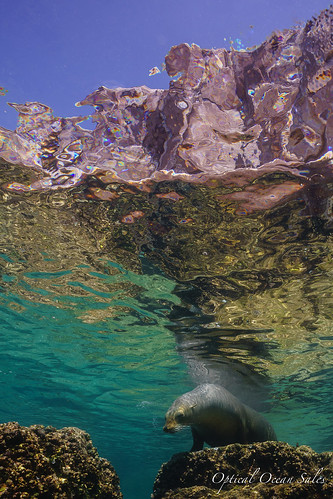Trip Report - Flower Garden Banks National Marine Sanctuary - July 2014 - By David Todd
Recently
I had a chance to dive on some of the healthiest coral reefs in the
world off the coast of Galveston, Texas in the Gulf of Mexico.
The
Gulf is not known for it’s pristine waters. With two-thirds of the US
draining into it, it tends to be muddy, filled with oil and gas
platforms and wouldn’t be most people’s first choice when searching for a
dive destination.
Those folks are missing out.
The Flower
Garden Banks National Marine Sanctuary, one of thirteen Marine Sanctuaries administered by NOAA, contains 350
acres of some of the healthiest coral reefs in the world, with up to
55% live coral coverage. To put this in perspective, the coral coverage
in the Caribbean averages in the teen percentages.
The reefs at
Flower Garden and Stetson Banks are the Northern-most tropical reefs in
the continental US and are part of the US’s National Marine Sanctuary
system. The nearest tropical reefs are 400 miles south in Mexico.
Since
they range from 80 to 110 miles offshore, they don’t get a lot of
traffic from divers, in fact there is only one regularly scheduled
live-aboard that services the area. Leaving from Freeport, Texas, about
an hour from Galveston, The
MV Fling holds and up to thirty divers and
does two and three day trips to introduce folks to the “Texas
Caribbean.”
You board at night and the vessel steams through the night to get out to these gorgeous reefs.
This
trip is not for the faint of heart. It is somewhat advanced diving,
both because of the depth of the reefs, average 65-75 feet for the top
of the reefs and the variable strong currents that can occur at the
bottom, mid water and at the surface.
Water
entrances and exits are somewhat athletic, with a 6-foot giant stride
entry and a trailing line exit to the ladder that can feel like a bit of
a Nantucket Sleigh Ride when the surface currents are up. Also the dive
masters on this boat are very thorough in their safety and site
briefing, but they do not accompany you on your dives. You will want to
be comfortable in your abilities to dive there.
Winter is the time
for schooling Hammerheads and occasional Tiger sharks, but during our
summer visit we were treated to Mantas and a school of 7 30+-foot Whale
Sharks. Great Barracudas and large jacks accompanied us on every dive,
sometimes in schools of over 100 fish.
In general, the Flower
Garden Banks reefs are large colonies of coral of 25 different species,
populated with large snapper, masses of Creolefish and grunts and an
occasional Spotted Drum and other exotics as well as a host of gulf
invertebrates from huge sponges to slate pencil urchins.
Stetson’s
rocky terrain is often described as a moonscape; It’s upswept rocky
ridges are home to large schools of Vermillion Snapper, Queen Conchs,
the rare Golden version of the Spotted Trunkfish and a resident Sandbar
shark, that we were lucky enough to watch in hunting mode.
Night
dives at Stetson were equally as fascinating as the day, with all of the
nocturnal animals like Beaded Sea Cucumbers, sea urchins, Slipper
Lobsters and decorator crabs foraging over the reef while the day fish
slept. We had to take care to not spotlight the sleeping fish in order
to keep them safe from the hungry jacks that opportunistically use
divers lights as a hunting tool.
In addition to the Flower Garden
Banks and Stetson Banks, most trips also dive on an oil platform or two.
This is truly a spectacular experience, as these massive steel
structures form artificial reefs and are teaming with life, from tiny
macro critters like blennies and gobies, bizarre alien fish like the
large scrawled filefish and cowfish to schools of large pelagics like
jacks and sharks. In fact, we had a great several minute visit from a
curious Silky Shark while hanging on our safety stop at Platform High
Island 389 which is known as one of the top ten oil platform dives in
the world.
Needless to say, there were amazing opportunities for
photography and videography on this trip. From big animals to macro it
was there. However, I was there on a biological survey trip with a group
of marine educators and photography took back seat to our surveying
activities.
I was able to shoot a bit of video in which you can get a glimpse of some of the life there.
Flower Garden Banks National Marine Sanctuary - Sony RX 100-II 60p Underwater Video
from Optical Ocean Sales on Vimeo.
I
am looking forward to getting back to the Gardens for a winter trip and
I will definitely take my camera on every dive next time!
Equipment Used:
- Sony Rx100 - II
- Sea and Sea MDX RX100 Housing
- Fisheye Fix 2k Video Light
- I-Das arms and Tray
Links:
Flower Garden Banks National Marine Sanctuary
Fling Charters
 Underwater photographers who travel and want a pro-level camera have been stuck with much larger, heavier full-frame DSLR camera systems. The choice was to compromise quality and capability for smaller size mirrorless cameras, or just deal with the extra weight, bulk and travel expense. In these days of add-on airline fees, this situation has been getting worse.
Underwater photographers who travel and want a pro-level camera have been stuck with much larger, heavier full-frame DSLR camera systems. The choice was to compromise quality and capability for smaller size mirrorless cameras, or just deal with the extra weight, bulk and travel expense. In these days of add-on airline fees, this situation has been getting worse.



















